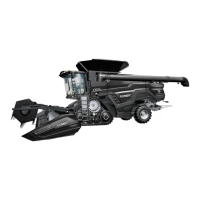1.7 Additional safety information
1.7.1 Noise emissions
In compliance with the directive machinery
2006/42/EC, the noise emission level is measured
at the point of the operator's ear in the cab (as
specified in EN ISO 4254-7 standard Annex C).
Basic test conditions when:
• The machine is parked.
• The engine is at maximum speed.
• The threshing system and header are engaged.
• There is no grain in the machine.
• The door is closed.
On these machines you only have a noise
emission more than 80 dB(A) if you operate the
machine with the door open.
In situations where the noise emission is more
than the maximum dB(A) value specified in local
law, put on ear protection.
GUID-26A7EE13-B26E-464C-8FE9-93348B7E58AF-high.jpg [High]
Fig. 24
Engine Noise level in the cab Noise level of the machine (Drive
by noise 2009/63/EC)
All engines 76 dB(A)
1
88 dB(A)
1
More or less than 2 dB(A).
1.7.2 Vibrations in the cab
In compliance with the European directives and subsequent updates:
• 2002/44/EC
• 2006/42/EC
The vibration level that the machine transmits to the body of the operator (on the operator seat) must not
be higher than the values shown.
Longitudinal
acceleration (m/s
2
)
Lateral acceleration
(m/s
2
)
Vertical acceleration
(m/s
2
)
Middle area of the body
bandwidth <0.5 bandwidth <0.5 bandwidth <0.5
Arm, hand
bandwidth <2.5 bandwidth <2.5 bandwidth <2.5
To obey the ISO 5008 standard, measure the vibration levels in 3 dimensions at the operator's seat.
Do the vibration test in the usual work conditions. The operator seat is in compliance with the directive
78/764/EC (and subsequent updates).
The vibrations in the cab can increase if:
• You operate the machine incorrectly.
• You do not do the maintenance on the machine.
• The conditions in the work area change.
NOTE:
[V]
GUID-46926F56-D606-49B1-8569-2DCA3A278BB4 [V2]
GUID-8FC0ADE3-42A6-4C96-A78D-C4F4512EAC58 [V2]
1. Safety
38 IDEAL Series Combine
ACX2738370

